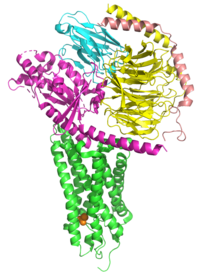
Photo from wikipedia
Abstract Microcystins are cyclic heptapeptide toxins produced by cyanobacteria that are frequently detected in surface waters during seasonal blooms. Chemisorption of microcystin through covalent bond formation to the acryloyl group… Click to show full abstract
Abstract Microcystins are cyclic heptapeptide toxins produced by cyanobacteria that are frequently detected in surface waters during seasonal blooms. Chemisorption of microcystin through covalent bond formation to the acryloyl group common to all congeners was hypothesized to be a high affinity adsorption mechanism. Sol-gel derived organosilica materials were synthesized as sorbents that could potentially facilitate a Michael addition reaction between an immobilized thiol group on the adsorbent and the acryloyl group of microcystin. Amine groups were also added to the organosilica to catalyze the thiol addition reaction at neutral pH. Adsorption isotherms of microcystin-LR, -LA, and –RR were measured for sol–gel derived sorbents and compared to adsorption by wood-based powdered activated carbon, which has been demonstrated to be an effective adsorbent for microcystin. The amine/thiol containing organosilica demonstrated a broad specificity to remove all three congeners from water. Adsorption capacities for MC-LR from natural water were reduced compared to deionized water, especially for the thiol-amine organosilica media. Adsorption of Cu(II) ions by the amine/thiol organosilica was measured which indicated metal ions were bound, however, the degree of metal ion binding was insufficient to significantly decrease adsorption microcystin. Overall, the reaction of microcystin with a surface thiol appeared to be promoted by an initial physical adsorption event and thiol deprotonation by the amines to create a better nucleophile for the Michael addition reaction.
Journal Title: Separation and Purification Technology
Year Published: 2018
Link to full text (if available)
Share on Social Media: Sign Up to like & get
recommendations!